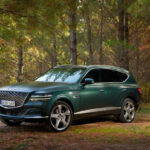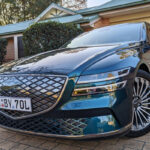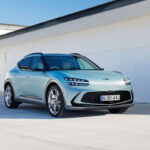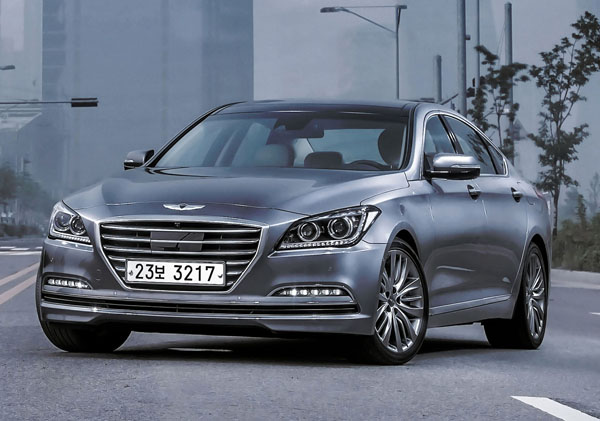
from Seoul, South Korea
Hyundai is keen to lift its image in Australia with an all-new upmarket model called Genesis.
Though the Genesis has been sold in other countries since 2009 it has previously been built only with the steering wheel on the left. That situation has been rectified in the second generation Genesis so imports to Australia can begin.
That’s the good news, there’s minor bad news in that the V8 models still aren’t being made with the steering wheel on the Australian side. However, after driving hundreds of kilometres in the 3.8-litre V6 that is coming downunder we feel it offers more than enough performance for most drivers.
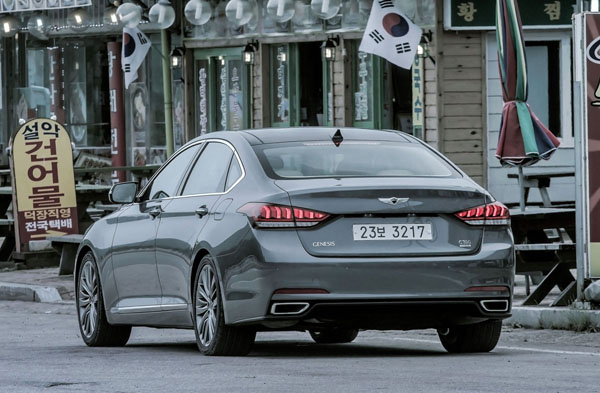 Hyundai Genesis is a large car, being slightly bigger than Commodore and Falcon. It’s also larger than the cars Hyundai sees as Genesis’ biggest competitors – Audi A6, BMW 5 Series and Mercedes-Benz E-Class.
Hyundai Genesis is a large car, being slightly bigger than Commodore and Falcon. It’s also larger than the cars Hyundai sees as Genesis’ biggest competitors – Audi A6, BMW 5 Series and Mercedes-Benz E-Class.
Tackling the big name Germans sounds ambitious? Yes, but Hyundai arguably has bigger ambitions than just about any other car maker. We’ve visited the company’s head office in Seoul several times over many years, and have come away with doubts in our minds when we’ve heard its longterm plans – only to have been proven wrong in the past.
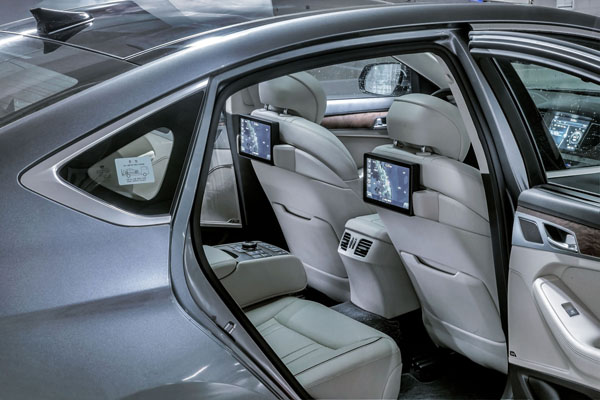
STYLING
Conservative sleekness is probably the best way to describe the Hyundai Genesis. Though it’s not as radical in its looks as the smaller Hyundai models, its slightly toned down look is just right for this upmarket area.
Interestingly, the body design is chiefly the work of an Australian born Korean, Casey Hyun.
The body theme is based around a new single-piece grille that works nicely to our eyes. This grille theme will eventually become the face of Hyundai as it’s introduced in others in the range.
The side profile is nicely curved and almost comes into four-door coupe territory. However, there’s good headroom in the rear, something that’s not always found in this semi-coupe class.
Tail treatment has a built-in spoiler lip and a wide stance that gives Genesis a powerful look from the rear.
Interior style and quality are particularly impressive; there’s leather with a hand-stitched look, real timber, suede and aluminium. The in-cabin feel is likely to be a major selling feature of the new Genesis.
ENGINE / TRANSMISSION
Only one engine is to be offered in Australia, a modern 3.8-litre direct-injection petrol V6 developing 235 kilowatts of power and 400 Nm of torque.
Transmission is by an eight-speed automatic to the rear wheels. Rear-wheel-drive is considered mandatory in every vehicle in this upmarket class.
INFOTAINMENT
The Hyundai Genesis is crammed with the latest in in-car entreatment, including a 17-speaker Lexicon audio system. Bluetooth, USB and Aux inputs are installed.
SAFETY
There are numerous crash avoidance or minimisation features, including all-round electronic vision, automatic emergency braking, lane keeping, radar cruise control, and a large, coloured head-up display.
The Genesis even helps to protect your licence. Using satellite navigation information it automatically slows the car as you approach fixed speed cameras, then returns to its original speed when the danger zone has been safely negotiated.
DRIVING
Seat comfort is very good and there’s enough support without the seat bolsters being overly aggressive. The rear seat provides good head and legroom. Three can be carried, but as is the norm in rear-drive cars some foot comfort is stolen by the necessary transmission tunnel.
The centre armrest in the rear folds down to provide access to many functions such as the ventilation system, even the satellite navigation settings, the latter displayed by screens in the rear of the front seats. Given the upmarket feel of the rest of the interior the plastic mountings for the rear-seat screens aren’t to the high standard anticipated.
Hyundai’s 3.8-litre V6 engine is a stunner, it is not only responsive and torquey throughout its range, but also provides the sort of intake and exhaust sounds drivers love to hear when the car is punted hard. The car may be relatively conservative, but the aural output is anything but. We love it.
The body is strongly built and this helps damp noise and vibration to impressively low levels. We’ve obviously yet to pit the body and suspension against Australia’s notoriously harsh coarse-chip surfaces, but will do so when the first shipment arrives towards the end of the third quarter this year and bring full reports then.
Our test vehicles were to Korean specifications as final testing in Australia is still to be completed. Ride comfort is generally good, but some midsize potholes did catch it out at times. Generally buyers in this class put comfort ahead of sporty road grip, although most Australians do like a bit of feel and feedback as well.
Road grip is safe and the car is nicely balanced. Attacking bends on winding roads brings in more body roll and understeer than we like – but see the aforementioned remarks about buyers preference for comfort in cars like this.
SUMMING UP
Hyundai’s desire to lift its image from value-for-money to upmarket high-tech machines is a bold move and we would like to see it being successful.
Interestingly, a factor in Genesis’ favour may be the upcoming withdrawal of Holden Commodore and Ford Falcon – leaving a huge gap in the affordable family car segment. The Hyundai is the same size as these about to be missed Aussie favourites. Though prices of the Korean machine are still to be set, they may well be at similar levels to the middle to top end Holdens and Fords.
Interesting times are ahead…




